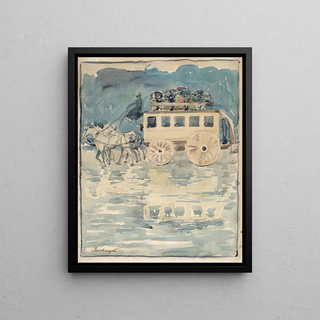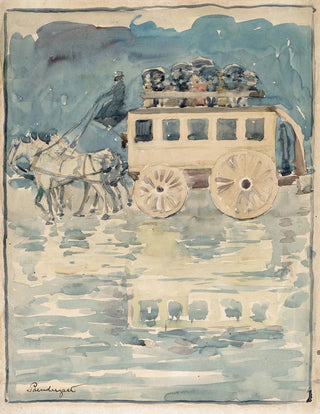Art print | Omnibus parisien - Maurice Prendergast


View from behind

Frame (optional)
Parisian Omnibus Art print - Maurice Prendergast – Engaging Introduction
In the early 20th-century art scene, Maurice Prendergast stands out for his ability to capture the vibrant essence of urban life. The "Parisian Omnibus" art print embodies this dynamism, offering a window into the bustling energy of Paris at a time when modernity was taking hold. Through a vivid palette and stylized forms, Prendergast manages to evoke not only a place but also an atmosphere, a sense of movement and collective joy. The art print of this work invites the viewer to immerse themselves in this colorful universe, where each character seems to have their own story, and where the urban landscape becomes a character in its own right.
Style and uniqueness of the work
The "Parisian Omnibus" art print is characterized by its Post-Impressionist style, which is expressed through bold brushstrokes and an innovative use of color. Prendergast plays with contrasts, highlighting bright hues that illuminate the scene while adding emotional depth. The human figures, though stylized, are full of life and energy, capturing the immediacy of a city stroll. The artist does not merely reproduce reality; he interprets it, transforming everyday life into a visual celebration. The flowing lines and ornamental motifs, typical of his work, create a rhythm that guides the eye through the composition, making each observation fresh and fascinating.
The artist and his influence
Maurice Prendergast, born in 1858 in Saint-Étienne, is an American artist who mastered European influences while developing a personal style. His fascination with light and color, inherited from the Impressionists, combines with a modern sensibility unique to him. Prendergast was a pioneer in integrating urban life into art, paving the way for many artists who followed. His work was also influenced by the Arts and Crafts movement, whose aesthetic principles shaped his approach to decoration and composition. Exhibiting his works alongside iconic figures such as Monet and Degas, he established himself

Matte finish

View from behind

Frame (optional)
Parisian Omnibus Art print - Maurice Prendergast – Engaging Introduction
In the early 20th-century art scene, Maurice Prendergast stands out for his ability to capture the vibrant essence of urban life. The "Parisian Omnibus" art print embodies this dynamism, offering a window into the bustling energy of Paris at a time when modernity was taking hold. Through a vivid palette and stylized forms, Prendergast manages to evoke not only a place but also an atmosphere, a sense of movement and collective joy. The art print of this work invites the viewer to immerse themselves in this colorful universe, where each character seems to have their own story, and where the urban landscape becomes a character in its own right.
Style and uniqueness of the work
The "Parisian Omnibus" art print is characterized by its Post-Impressionist style, which is expressed through bold brushstrokes and an innovative use of color. Prendergast plays with contrasts, highlighting bright hues that illuminate the scene while adding emotional depth. The human figures, though stylized, are full of life and energy, capturing the immediacy of a city stroll. The artist does not merely reproduce reality; he interprets it, transforming everyday life into a visual celebration. The flowing lines and ornamental motifs, typical of his work, create a rhythm that guides the eye through the composition, making each observation fresh and fascinating.
The artist and his influence
Maurice Prendergast, born in 1858 in Saint-Étienne, is an American artist who mastered European influences while developing a personal style. His fascination with light and color, inherited from the Impressionists, combines with a modern sensibility unique to him. Prendergast was a pioneer in integrating urban life into art, paving the way for many artists who followed. His work was also influenced by the Arts and Crafts movement, whose aesthetic principles shaped his approach to decoration and composition. Exhibiting his works alongside iconic figures such as Monet and Degas, he established himself






